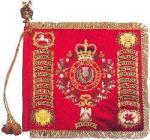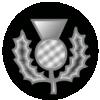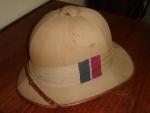-
Posts
1,761 -
Joined
-
Last visited
-
Days Won
3
Content Type
Profiles
Forums
Blogs
Gallery
Events
Store
Everything posted by Stuart Bates
-
Well Michael this is just about the worst example of this style of helmet I have seen. You are right about the ear bosses they are not correct for the 3rd Dragoon Guards. The plume should be black over red, trumpeters wore white until c1902 when they changed to yellow. The chinchain is in terrible condition as is the interior. The skull would possibly polish up OK, although the rear brim looks a little rough, but I wouldn't touch this one unless it were given to me. I don't know off-hand how it can be described as post 1881 or what that actually means. It is the 1871+ pattern. Stuart
-
I have just bought a Wolseley helmet to the Northumberland Fusiliers and wondered if anyone (Graham) could identify the battalion. Was the red stripe to the puggaree for regular battalions only or all battalions? A friend supplied the following information - The 2nd Battalion was in Alexandria from October 1915 until November 1915 and then went to Salonika until 1918. 2/7th Battalion (Territorial) went to Egypt in 1917 on garrison duty. 1st Garrison Battalion went to Malta (1915?). 2nd Garrison Battalion went to India in 1916. If the stripe was for regulars only then it is the 2nd, otherwise could be any of the above. There is only the War Department stamp inside with 162 on top and O to the bottom of the stamp. Thanks, Stuart
-
Michael, as a start I would ask for a shot of the interior, side and top of the helmet. The first would establish the quality and correctness of the headlining, the others the correctness of the ear bosses and the plume rosette. The chinchain worries me because it is described as graduated which was for the Household Cavalry only. Dragoon Guards and Dragoons had a 3/4" wide chinchain until about 1900 when the width was increased to 1". I would also query the background of the regimental number within the garter as it should be black leather or black japanned metal. Stuart
-

Photo Help
Stuart Bates replied to Bear's topic in Great Britain: Militaria: Badges, Uniforms & Equipment
The man in the left image appears, at first, to be an officer of the 3rd Hussars (scarlet facings) which converted from Light Dragoons in 1861 (facing colour to the collar only from that year). However, The 1846 Dress Regulations (DRs) state a Prussian collar and 5 rows of gold buttons etc. This image shows 5 rows with olivets(?) and a round collar. Now the number of rows increased in about 1855 to 6 and was specified as such in the 1857 DRs, as was the rounded collar. I don't have the 1855 DRs but I understand that the 1857 mirrors that one in this respect. So we have a mismatch between the number of rows on the breast and the shape of the collar. The scarlet to the cuffs is a mystery too. However, ... The Light Dragoons wore a Hussar style jacket with 5 rows to the breast with collar and cuffs in regimental facings according to the 1857 DRs. The facings were scarlet in the case of the 4th Light Dragoons which also converted to Hussars in 1861 but whose facings changed to blue at that time. The fly in the ointment here is that the forage cap should have an embroidered peak but many examples exist of peakless caps, most notably one of a Lt Hutton, of the 4th LD, which is held in the National Army Museum. I therefore plump for an officer of the 4th Light Dragoons pre-1861. Stuart -

2nd Dragoons Badge
Stuart Bates replied to Michael NA's topic in Great Britain: Militaria: Badges, Uniforms & Equipment
Michael, I have bought several photos from the Soldiers of Gloucestershire Museum so you might like to try the museum of the Royal Scots Dragoon Guards. There is a company in the UK which has over 25,000 photographs for sale and their name is D P & G Publishing. The drawback with them is that they have no website, nor email address and don't give out their 'phone number so it's snail mail or nothing. If you want their address send me a PM. Stuart -

2nd Dragoons Badge
Stuart Bates replied to Michael NA's topic in Great Britain: Militaria: Badges, Uniforms & Equipment
Hi Michael, I was perusing the dealers' sites when I came across your badge on a Glengarry at Blunderbuss Antiques. You may like to ask them what regiment it belongs to. http://www.blunderbuss-antiques.co.uk/shop...2352&phqu=1 Stuart -

2nd Dragoons Badge
Stuart Bates replied to Michael NA's topic in Great Britain: Militaria: Badges, Uniforms & Equipment
Michael, I decided to look in the Dress Regulations to see if they had anything on the guidon and stumbled on the badge being for the bearskin cap. A bit of serendipity at play! Glad to be of assistance. Stuart -

2nd Dragoons Badge
Stuart Bates replied to Michael NA's topic in Great Britain: Militaria: Badges, Uniforms & Equipment
Michael, this is the current standard of the Royal Scots Dragoon Guards (2Ds, 3DGs and 6DGs) and the badge of the Order of the Thistle was previously on the Scots Greys Guidon. Stuart -

2nd Dragoons Badge
Stuart Bates replied to Michael NA's topic in Great Britain: Militaria: Badges, Uniforms & Equipment
Michael, I got this from the Regiments site - "The Greys formed part of Ponsonby's Brigade during the Waterloo campaign of 1815. On receiving the order to advance at Waterloo they charged to shouts of " Scotland for ever!" and many of the Gordon Highlanders are alleged to have grasped the stirrups of the Greys to keep up with them. In the charge 2,000 prisoners were taken and Sergeant Ewart of the Greys captured the "Eagle" of the 45th French Infantry. For their services in this campaign the Greys received Royal permission to bear on their guidon the badge of an Eagle and the word " Waterloo." And here is something of interest. The 1857 to 1894 Dress Regulations specify a gilt thistle to be worn on the front of the bearskin cap. The Drs of 1822, 1834, 1846 and 1900 don't specify this. Stuart -

2nd Dragoons Badge
Stuart Bates replied to Michael NA's topic in Great Britain: Militaria: Badges, Uniforms & Equipment
Michael, I just came across some divisional signs of the British Army for WWI and a simple thistle was the insignia of the 9th (Scottish) Division. This insignia was in existence until about 1945. Hope this helps. Stuart -

2nd Dragoons Badge
Stuart Bates replied to Michael NA's topic in Great Britain: Militaria: Badges, Uniforms & Equipment
Hi Michael, do check with regimental museums, although you will get mixed results, from really quick responses to having to wait a week or two, to no response at all. I'm no expert on badges especially Scottish ones as I concentrate on English stuff but I do have a lot of reference books. No doubt you will post your findings but I am sure that you will get some good information from other members of the forum. Most of my helmets were sourced in the UK although quite a few were bought here in Australia, but with the pound being so strong for so many years there simply aren't many dealers left and they don't have much if anything in stock! Good luck with the "badge" and that first site I mentioned did describe the item as a sporran badge albeit with the crown. Stuart -

2nd Dragoons Badge
Stuart Bates replied to Michael NA's topic in Great Britain: Militaria: Badges, Uniforms & Equipment
Hi Michael, the 2nd Dragoons wore a grenade device as a plume holder on their bearskin full-dress cap and an eagle with the battle honour Waterloo on other headdress etc. Your badge seems to be part of a cap or sporran badge of perhaps the Queens's Own Highlanders (Seaforths and Camerons). Check out this site http://houseoflabhran.net/insignia.html and http://www.regiments.org/about/index.htm. You will notice that the device you show does not have the usual crown to the top which is why I say it may be one element of a multi-part device. Stuart -

1834 Pattern Dragoon Helmet
Stuart Bates replied to dorval's topic in Great Britain: Militaria: Badges, Uniforms & Equipment
Hi Dorval, I have this model as well. I specialise in British headdress of the 19th century and have posted some of my collection under Collectors' Showcase "My British Headdress Collection". What other helmets do you have in your collection and will you be posting as I would love to see them? Stuart -
Hello Chris, you are correct my Signal Corps does have a more rounded front. This would be due to manufacturer's variations which we see in all styles of British helmets of this type ie. cork or pith. The photo is not very good but does illustrate your point (no pun? you bet). I am just getting ready for a street party and am in a rush so hope it suffices. And yes it is a private purchase helmet. Stuart
-

red coat
Stuart Bates replied to Mossy's topic in Great Britain: Militaria: Badges, Uniforms & Equipment
Somebody mentioned emmigration to Australia so I had a quick look. All I could come up with was a Harry Lomax, born Bolton, Lancashire, age 30 years and 4 months who enlisted in May 1915 and was killed at Gallipoli. I suppose it's a bit hard to believe that he could have been commissioned as 2nd Lt at the tender age of 15 years. Stuart





